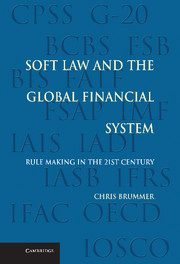Book contents
- Frontmatter
- Contents
- Acknowledgments
- Key Abbreviations
- Introduction The Perils of Global Finance
- 1 Territoriality and Financial Statecraft
- 2 The Architecture of International Financial Law
- 3 A Compliance-Based Theory of International Financial Law
- 4 How Legitimate Is International Financial Law?
- 5 Soft Law and the Global Financial Crisis
- 6 The Future of International Financial Law
- Index
- References
2 - The Architecture of International Financial Law
Published online by Cambridge University Press: 05 June 2012
- Frontmatter
- Contents
- Acknowledgments
- Key Abbreviations
- Introduction The Perils of Global Finance
- 1 Territoriality and Financial Statecraft
- 2 The Architecture of International Financial Law
- 3 A Compliance-Based Theory of International Financial Law
- 4 How Legitimate Is International Financial Law?
- 5 Soft Law and the Global Financial Crisis
- 6 The Future of International Financial Law
- Index
- References
Summary
Financial globalization makes international engagement necessary as mobile market participants and capital more easily escape unilateral national regulatory supervision. Regulatory authorities have responded to the challenge by seeking to promulgate global standards, best practices, and prudential guidelines through a range of international forums and organizations. That international institutions should constitute focal points for such interactions is not surprising. Because of the constantly evolving nature of the global capital markets, many problems require continuous attention and new policy solutions rather than one-shot solutions. In such a world, corralling purely ad hoc alliances to deal with regulatory problems as they arise is a highly inefficient approach. Institutions help actors develop habits of cooperation and allow sustained attention to be brought to bear on common problems.
That said, the forums in which regulators participate are qualitatively different from those that have traditionally preoccupied theorists and practitioners of international law. Since the nineteenth century, international (or “global”) rule making has been increasingly the province of “international organizations” – institutions defined by academics as grounded in a formal ratified treaty and enjoying “state membership, tangible manifestations of organizational bureaucracy, and an adequate legal pedigree.” Academics have extolled these features because they evince consent-based legitimacy: they require states to formally commit to participation along clearly demarcated terms specifying the powers and obligations of the body concerned. The powers accorded to such institutions have also often been considerable and include the ability to interpret the treaties on which they are based, adjudicate disputes, and supervise members’ conduct.
- Type
- Chapter
- Information
- Soft Law and the Global Financial SystemRule Making in the 21st Century, pp. 60 - 114Publisher: Cambridge University PressPrint publication year: 2011
References
- 1
- Cited by



